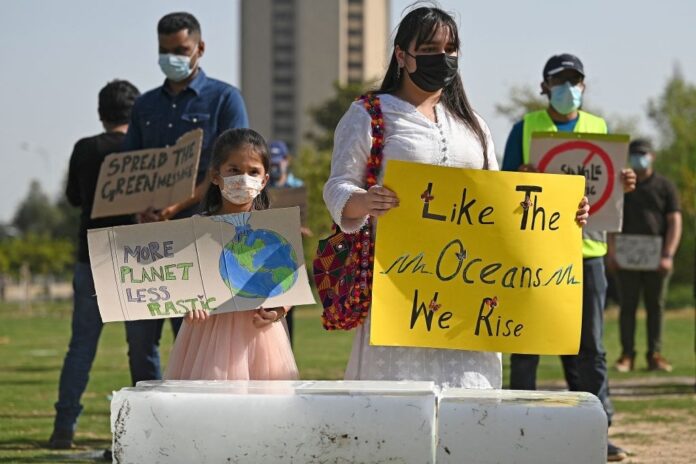BARCELONA: The UK hosts of the COP26 UN climate summit, starting October 31 in Glasgow, have said their key goal is to “keep 1.5 alive” — ensuring it remains possible to limit fast-accelerating global warming to 1.5 degrees Celsius above preindustrial times.
While meeting this target — the most ambitious aim of the Paris Agreement to tackle climate change — will not prevent extreme weather worsening or sea levels rising, it is seen as vital for avoiding runaway impacts on humans and the planet.
The problem is that planned efforts by the 195 countries that adopted the Paris pact in 2015 are so far not nearly enough to meet that target, analysts say.
The Intergovernmental Panel on Climate Change has said planet-heating emissions need to fall by 45 percent from 2010 levels by 2030, and then hit net-zero by mid-century, to have a good chance of keep warming to 1.5C.
A 25 percent reduction is needed this decade to limit planetary heating to 2C, the higher ceiling in the Paris Agreement.
But a report released Friday by the UN climate change body, which assessed new and updated climate action plans from the 113 countries that have so far filed them, said those commitments would bring greenhouse gas emissions down by only 12 percent by 2030.
The plans account for about half of global annual emissions.
More worrying, when the current commitments from all countries are taken together – including those that have not yet filed updates – analysts see about a 16 percent spike in emissions by 2030.
That could lead to a global average temperature hike of about 2.7C by the end of the century, the IPCC said – a level scientists have warned could drive surging crop failures, growing hunger, more migration and ever more extreme weather.
Is the 1.5C goal now effectively out of reach?
UN climate chief Patricia Espinosa told journalists on Friday she believed the window for keeping global warming to 1.5C was still open, although the IPCC had indicated it was a “very, very small window”.
The world has already heated up by about 1.1-1.2C, largely due to the carbon emissions from fossil fuels burned since the start of the Industrial Revolution.
In an August report, the IPCC said that unless immediate, rapid and large-scale action is taken to reduce emissions, the average global temperature is likely to reach or cross the 1.5C (2.7 degrees Fahrenheit) warming threshold within 20 years.
“One thing that we cannot do is give up,” Espinosa said, urging all countries that have yet to submit updated “nationally determined contributions” (NDCs) for emissions reductions and adaptation measures to do so before COP26.
Those that have already filed plans, she added, could still strengthen their targets going into the conference, which was postponed a year due to the coronavirus pandemic.
“No nation is immune (to the impacts of climate change) – we need all nations pulling together,” said Espinosa.
Which countries are pulling their weight towards 1.5C?
Research coalition Climate Action Tracker said in mid-September that momentum on updating 2030 targets had stalled since May.
No additional major emitters have stepped up since then, which means governments are so far offering only 15 percent of the cuts needed to meet the 1.5C goal, it noted.
It rated only one country — the tiny West African nation of Gambia — as having a climate plan consistent with the 1.5C limit. Another six nations – four of them in Africa – were rated as nearly sufficient.
Three other signatories to the Paris deal — the European Union, Germany and the United States — have significantly updated their targets with a raft of new policies, CAT said.
And while Britain’s emissions-cutting target is in line with the 1.5C goal, its policies to achieve that target and its international support to help poorer nations achieve their own goals fall short, CAT said.
Its latest assessment said three-quarters of the countries that signed the Paris Agreement still have national plans that do not align with the pact’s aims.
Bill Hare, CEO of CAT partner Climate Analytics, said Australia, Brazil, Indonesia, Mexico, New Zealand, Russia, Singapore, Switzerland and Vietnam were of particular concern.
Each has completely failed to lift their ambition from targets submitted in 2015, with some even lowering them in their new plans, he said.
“These countries need to rethink their choices,” Hare added.
He pointed out that while many governments have committed to reducing their emissions to net-zero by mid-century, many are failing to get to work now on that goal, making it “virtually impossible” to meet.
Why is pressure building on the world’s 20 biggest economies?
If the G20 group of major economies — accounting for 75 percent of greenhouse gas emissions — set ambitious emissions targets for 2030 and reached net-zero emissions by 2050, warming could be limited to 1.7C at the end of the century, a separate September report said.
The study from the World Resources Institute and Climate Analytics noted that current NDCs and legally binding net-zero targets put the world on a trajectory to 2.4C of warming this century.
To date, G20 nations Argentina, Canada, the EU, Britain and the United States have strengthened their 2030 emission reduction targets, while Japan, South Africa and South Korea have announced plans to do so later this year.
China, India, Saudi Arabia and Turkey — responsible for a third of global greenhouse gases — have yet to submit updated plans.
Australia and Indonesia, in turn, have put forward emissions reduction targets identical to those they offered in 2015, the report said.
Brazil and Mexico have submitted plans allowing higher emissions than their earlier targets, while Russia is now aiming for 2030 emissions even higher than its current “business-as-usual” trajectory.
What is needed to encourage the laggards to step up?
Climate analysts have pointed to a lack of financial support as one major stumbling block.
Wealthy governments promised at UN climate talks over a decade ago to gradually build up to channelling $100 billion a year from 2020 onwards to poorer, vulnerable nations to help them adopt clean energy and adapt to climate change.
But in 2018 and 2019, they provided less than $80 billion each year, with experts estimating the 2020 target was likely missed as economies were squeezed by the coronavirus pandemic.
Battered by the impacts of both Covid-19 and surging climate disasters, many developing countries and small island states say that without money they cannot launch the more aggressive climate action outlined in their national plans.
UN climate chief Espinosa noted that if wealthy governments did stump up the promised $100 billion in funding before COP26, it could open up “a big area of opportunity”.






















